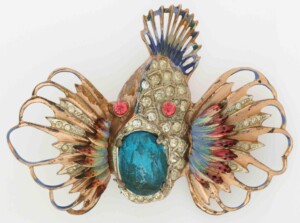CORO/ Cohn and Rosenberger (1901-1979)
CORO was founded in New York by Emanuel Cohn and Carl Rosenberger in 1901/1902. Both were not only talented businessmen but also persons with a good eye for the arts. They appointed Adolph Katz as director of design, and throughout the years the firm collaborated with a variety of talented jewelry designers who were allowed to develop their creative visions.
In the beginning, the manufacturing of the jewelry was outsourced until they established a factory in Providence, Rhode Island, in 1911. With offices or plants in New York and Providence, they had an important presence in Chicago, Los Angeles, San Francisco, Miami, Toronto, Mexico and the United Kingdom. The company not only survived the New York stock market crash of 1929, but it even thrived, eventually becoming the largest costume jewelry company in the United States.
Coro as a name was adopted in 1943. Other lines include Corocraft and Vendome. The variety of collections makes it a challenge to describe the essence of the Coro style as diversity was king for the firm. From figural to floral the essential underlining elements are romanticism and feminine appeal. Coro also produced a few patriotic jewelry pieces including the Emblem of America’s brooch during World War II, which are rare and sought after by collectors.
The most coveted of all styles is the Quivering Camellia Duette, designed in 1938 by Gene Verrecchio, a double clip that could be combined into one brooch through an innovative interlocking catch. While the duette clip remained popular through the late 1940s, other pieces took the fancy of the female consumer. One of the biggest trends was known as the trembler: this kind of jewelry consists of a component (commonly a flower) mounted on itty bitty metal springs, so when the wearer moves the jewelry shakes or ‘trembles’.
Among the well-known designers who collaborated with Coro were Gene Verrecchia (1933-1963), Charles E. Pauzat (1939-1940s), Oscar Frank Placco (1934-1945), Robert Geissman (1938), Sidney Pearl (1941), Carol McDonald (1940), Lester Gaba (1941), Marion Weeber (1940-1941), Victor di Mezza (1940).
CORO jewelry is collected worldwide and is displayed in Museum collections such as that of the Metropolitan Museum of Art, New York.
